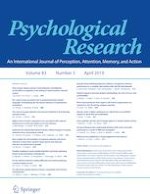29-08-2017 | Original Article
Set size influences the relationship between ANS acuity and math performance: a result of different strategies?
Gepubliceerd in: Psychological Research | Uitgave 3/2019
Log in om toegang te krijgenAbstract
Previous research has proposed that the approximate number system (ANS) constitutes a building block for later mathematical abilities. Therefore, numerous studies investigated the relationship between ANS acuity and mathematical performance, but results are inconsistent. Properties of the experimental design have been discussed as a potential explanation of these inconsistencies. In the present study, we investigated the influence of set size and presentation duration on the association between non-symbolic magnitude comparison and math performance. Moreover, we focused on strategies reported as an explanation for these inconsistencies. In particular, we employed a non-symbolic magnitude comparison task and asked participants how they solved the task. We observed that set size was a significant moderator of the relationship between non-symbolic magnitude comparison and math performance, whereas presentation duration of the stimuli did not moderate this relationship. This supports the notion that specific design characteristics contribute to the inconsistent results. Moreover, participants reported different strategies including numerosity-based, visual, counting, calculation-based, and subitizing strategies. Frequencies of these strategies differed between different set sizes and presentation durations. However, we found no specific strategy, which alone predicted arithmetic performance, but when considering the frequency of all reported strategies, arithmetic performance could be predicted. Visual strategies made the largest contribution to this prediction. To conclude, the present findings suggest that different design characteristics contribute to the inconsistent findings regarding the relationship between non-symbolic magnitude comparison and mathematical performance by inducing different strategies and additional processes.
